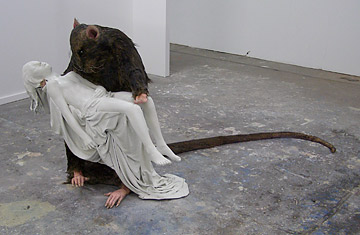
Child and Rat by Emer Roberts
There could perhaps be no better (or worse, depending on your religious inclination) day to open a blasphemous art exhibition than Good Friday. As many Irish Catholics were dutifully attending church, a group of young, well-dressed Dubliners gathered in the Irish Museum of Contemporary Art to view an exhibition inspired by the country's new — and much loathed — antiblasphemy law.
The first artwork to greet the visitors to "Blasphemous" is a grotesque variation on Michelangelo's Pieta, with the Virgin Mary transformed into a malicious giant rat. Next is a multimedia piece called Resur-erection that references the Irish Catholic sex-abuse scandals of recent months and features stop-motion priests and bishops in suspicious scenarios. Another exhibit simply and bluntly declares "F___ Christmas" in baubles and fairy lights. The reaction of gallery-goers on opening day ranged from bemusement to gratitude that at least one venue in Dublin's capital was serving alcohol on the most abstinent of Irish religious holidays. But for curator K. Bear Koss, the objective of the exhibition is very serious: "We want to raise awareness about the new blasphemy law," he says, "and to celebrate the freedoms of discourse that the law seeks to stifle."
The statute at the heart of the exhibition, which came into effect on Jan. 1, is actually an update to a dormant blasphemy law that had been included in Ireland's 1937 constitution but proved too vague to be enforceable. A parliamentary committee set up to overhaul the constitution issued a report in 2007 recommending that the old law be dropped altogether. But Justice Minister Dermot Ahern led a campaign to clarify the law instead, defining blasphemy as any statement "grossly abusive or insulting in relation to matters held sacred by any religion" and adding a fine of up to $34,000 for offenders. And despite public protests against the updated measure, Parliament passed it last year. According to Ahern's office, the minister felt that recasting the law was the only viable option. However, his office pointed out that the new law has an exception that should comfort artists like those featured in the blasphemy exhibition: it provides for a defense in cases of materials "that a reasonable person would find of genuine literary, artistic, political, scientific or academic value."
This safeguard has not stopped cultural and opposition figures from lining up to attack the new law as arcane and anachronistic. Leading the fray is the advocacy group Atheist Ireland, which in January defiantly published 25 blasphemous statements on its website by figures as diverse as atheist author Richard Dawkins and musicians Frank Zappa and Björk. "This is introducing medieval canon law into a modern pluralist republic," says the group's director, Michael Nugent. "There are other countries that do have blasphemy laws from bygone eras that are on the statute books but not enforced. Ireland is the only Western liberal democracy that is introducing new blasphemy laws in the 21st century." In a statement last year, Dawkins said, "The new blasphemy law will send Ireland back to the Middle Ages. It is wretched, backward and uncivilized."
To date, there have been no prosecutions under the law. But some feel that its mere presence on the books is already coloring debate in the country. "Even if there is no official appetite for a show trial, media outlets can't take the chance of the law not being enforced," Nugent says. "So there is a kind of self-imposed censorship." This would seem to be the case at national broadcaster RTE. While working on his irreverent television series The Savage Eye, which features excoriating sketches about the Catholic church, comedian Dave McSavage says he was sent a draft version of the law by his producers. "We were told to keep it in mind," he says. If anything, however, the law may simply provide added impetus for entertainers and artists to push the boundaries. "The recent activities of the Catholic church are much more of an outrage than anything the blasphemy law might be there to prevent," McSavage says. "Beside pedophilia and the scandalous cover-up that ensued, blasphemy pales into insignificance."
Because of the stinging criticism, the Irish government may now be reconsidering the move. Complaining that he has been the victim of "a sophisticated campaign, mostly on the Internet," Ahern last month proposed holding a referendum on the law, insisting that this was always his "preferred choice." However, with no date set for any referendum, opponents are keeping up the pressure. In May, Atheist Ireland will organize a 25-day walk across the country to hold public meetings on the statute, while the Museum of Contemporary Art is planning further one-off anti–blasphemy law events, as well as an exhibition this summer entitled "These Artists Are Criminals."
"Now that they say they are willing to hold a referendum, I think it is more important than ever to keep up the momentum," Koss says. "We need to keep people aware that this law is on the books and that it can be changed."
